Trust Models in Wireless Sensor Networks for Defending Against Denial-of-Service Attacks: A Literature Review
Abstract
1. Introduction
1.1. Wireless Sensor Networks and Network Architecture Types
1.2. WSN Vulnerabilities and Trust Models
1.3. Research Problem and Questions
- RQ1: What types of DoS attacks in WSNs can be addressed using trust models?
- RQ2: What trust evidence is required to identify DoS attacks effectively?
- RQ3: What approaches can be used to extract the required trust evidence?
- RQ4: What methods for trust evaluation can be used?
- RQ5: What are the key challenges to applying trust models for the defense of WSNs against DoS attacks?
1.4. Study Contributions
- This study develops a comprehensive classification of the types of DoS attacks in WSNs that can be addressed using trust models, including their key attack features and impact mechanisms.
- By analyzing the key features of these DoS attacks, we identify the trust evidence that trust models are required to recognize DoS attacks effectively.
- This study identifies, analyses, and compares the methods for extracting trust evidence.
- This study provides a comprehensive summary of trust evaluation methods.
- This study identifies the key challenges in applying trust models for the defense of WSNs against DoS attacks.
2. Methodology
2.1. Inclusion and Exclusion Criteria
2.2. Search Strategy
2.3. Screening and Selection Process
2.4. Data Extraction and Synthesis Methods
3. Key Technologies in Trust Management for WSNs
3.1. DoS Attacks in WSNs
3.2. Trust Evidence
3.3. Approaches to Extracting Trust Evidence
3.3.1. Extracting Packet Sending Rate
3.3.2. Extracting Packet Receiving Rate
3.3.3. Extracting Packet Forwarding Rate
3.3.4. Extracting the Energy Consumption Rate
3.3.5. Extracting Data Accuracy
3.4. Trust Evaluation Methods
3.4.1. Direct Trust Evaluation
- Threshold-limiting methods
- Success–failure methods
3.4.2. Indirect Trust Evaluation
- Dempster–Shafer
- Arithmetic Mean
- Weighted Average
- Outlier detection
- Forgetting Curve
- Intrusion Detection System
- Method Based on Link Quality and Node Reliability
- Selective Re-evaluation Method
3.4.3. Updating the Trust Value
- Weighted Average
- Improved Weighted Average
- Time Lapse Factor
4. Challenges
4.1. Threshold Limits
4.2. Weighting Trust Evidence Metrics
4.3. Loss of Trust Information
4.4. Link Quality
4.5. Authentication Delay
4.6. Trust-Based Routing
5. Conclusions
Author Contributions
Funding
Conflicts of Interest
Appendix A
| No | Author, Year | Trust Evidence | Direct Trust | Indirect Trust | Evaluation Methods | Trust Metric Range | Distributed | Centralized | Hybrid | Detect Attacks | Defend attacks | DoS Attack Types | Simulation Tool | Domain |
|---|---|---|---|---|---|---|---|---|---|---|---|---|---|---|
| 1 | Ganeriwal et al., 2004, 2008 [5,38] | Forwarding trust, data trust. | ✓ | ✓ | Bayesian beta method, aging factor, Dempster–Shafer belief theory and concept of belief discounting. | A realm number between 0 and 1 | ✓ | ✓ | ✓ | Bad-Mouthing Attack, Good-Mouthing Attack, Sybil Attack. | NESLsim | WSN | ||
| 2 | Cao et al., 2006 [36] | Ratio of the number of successfully solved puzzles to the number of packets sent. | ✓ | Take the logarithm of the ratio. | Negative real numbers less than or equal to 0 | ✓ | ✓ | ✓ | Flooding Attack. | Not mentioned | WSN | |||
| 3 | Cho and Qu, 2013 [37] | Forwarding trust. | ✓ | Bayesian beta method, entropy-based trust models. | A realm number between 0 and 1 | ✓ | ✓ | ✓ | Selective Forwarding Attack. | OPNET | WSN | |||
| 4 | Han et al., 2014 [40] | Energy consumption, probability of packet reached successfully (PPRS). | ✓ | Bayesian beta method, aging factor. | A realm number between 0 and 1 | ✓ | ✓ | Selective Forwarding Attack, Flooding Attack. | NS2 | Cluster-based WSN | ||||
| 5 | Gautam and Kumar, 2018 [39] | Probability of packet reached successfully (PPRS). | ✓ | ✓ | Bayesian beta method, forgetting curve. | A realm number between 0 and 1 | ✓ | ✓ | Unclassified. | Not mentioned | Cluster-based WSN | |||
| 6 | Jinhui et al., 2018 [13] | Energy consumption, power consumption sequence. | ✓ | Bayesian beta method, penalty factor, threshold, Pearson correlation coefficient. | An unsigned integer between 0 and 10 | ✓ | ✓ | Hybrid DoS Attacks. | NS2 | Cluster-based WSN | ||||
| 7 | Wang et al., 2018 [4] | Data forwarding trust, control forwarding trust, packet-in trust. | ✓ | Bayesian beta method, weight, threshold. | Local trust: an unsigned integer between 0 and 10 Global trust: a realm number between 0 and 1 | ✓ | ✓ | ✓ | Selective Forwarding Attack, New-Flow Attack. | Contiki Cooja 2.7 | SDWSN | |||
| 8 | Anwar et al., 2019 [35] | Packet Received Evaluation (PRE), Packet Sending Evaluation (PSE), Transit Packet Evaluation (TPE). | ✓ | ✓ | Bayesian beta method, weight. | A realm number between 0 and 1 | ✓ | ✓ | On–Off Attack, Bad-Mouthing Attack, DoS Attack. | OMNET++ | WSN | |||
| 9 | Usman et al., 2019 [7] | Data rate. | ✓ | Threshold. | Trust or not trust | ✓ | ✓ | ✓ | Unclassified. | MATLAB | WBAN | |||
| 10 | Lyu et al., 2019 [41] | Forwarding trust. | ✓ | Aging factor. | A realm number between 0 and 1 | ✓ | ✓ | ✓ | Unclassified. | OPNET | IoT | |||
| 11 | Bin-Yahya and Shen, 2019 [45] | Forwarding trust, sending-rate trust, new-flow trust. | ✓ | ✓ | Bayesian beta method, weight, aging factor. | A realm number between 0 and 1 | ✓ | ✓ | Blackhole Attack, Selective Forwarding Attack, DoS Attack. | MATLAB | SDWSN | |||
| 12 | Wu et al., 2019 [14] | Communication trust, data trust, energy trust. | ✓ | ✓ | Bayesian beta method, weight, threshold, aging factor, LQI analysis. | A realm number between 0 and 1 | ✓ | ✓ | Selective Forwarding Attack, DoS Attack. | MATLAB | WSN | |||
| 13 | Qureshi et al., 2020 [15] | The number of sent packets, the number of received packets, the time of sending packets, the time of receiving packets, and the packet loss rate between two nodes. | ✓ | ✓ | Bayesian beta method, threshold. | A realm number between 0 and 1 | ✓ | ✓ | ✓ | On and Off Attack, Bad-Mouthing Attack, DoS Attack. | OMNET++ | IoT | ||
| 14 | Su et al., 2020 [18] | Communication trust, data trust, energy trust. | ✓ | ✓ | Bayesian beta method, weight, threshold, aging factor. | A realm number between 0 and 1 | ✓ | ✓ | Selective Forwarding Attack, Flooding Attack. | MATLAB | UASN | |||
| 15 | Anand and Vasuki, 2021 [34] | Throughput, packet rate, packet forwarding rate, hop count, energy utilization. | ✓ | ✓ | An improved statistical method of the grading factor with the probability weight factor, Fleiss kappa function. | A realm number between 0 and 1 | ✓ | ✓ | Selective Forwarding Attack, Flooding Attack. | NS-2.33 | WSN | |||
| 16 | Rahamathullah and Karthikeyan, 2021 [24] | Data packet forwarding ratio, control packet forwarding ratio, energy consumption. | ✓ | ✓ | Weight, threshold. | A realm number between 0 and 1 | ✓ | ✓ | ✓ | DDoS Attack. | Contiki Cooja 3.0, Tmote sky wireless sensor board | IoBT | ||
| 17 | Isaac Sajan and Jasper, 2021 [16] | The quantity of the packet delivered successfully, the previous history of packets dropped by the nodes, the similarity in attributes. | ✓ | ✓ | Weight, threshold. | A realm number between 0 and 1 | ✓ | ✓ | ✓ | Vampire Attack. | MATLAB | Ad hoc sensor network (WANET) | ||
| 18 | Rani et al., 2021 [42] | Data trust, community trust. | ✓ | ✓ | Weight. | A realm number between 0 and 1 | ✓ | ✓ | ✓ | Unclassified. | OMNET++ | Cluster-based WSN | ||
| 19 | Yuvaraj et al., 2022 [43] | Forwarding trust, IMFs. | ✓ | Weight, DR-HHT, correlation coefficient, Kolmogorov–Smirnov test. | A realm number between 0 and 1 | ✓ | ✓ | ✓ | LDoS. | MATLAB | IoT WSN | |||
| 20 | Bin-Yahya et al., 2022 [10] | Forwarding trust, sending rate trust, new-flow trust, node reliability. | ✓ | ✓ | Bayesian beta method, weight, threshold, aging factor, reward and penalize. | A realm number between 0 and 1 | ✓ | ✓ | Blackhole Attack, Selective Forwarding Attack, DoS Attack, Good-Mouthing Attack, On–Off Attack, Hybrid DoS Attacks, New-Flow Attack. | MATLAB | SDWSN | |||
| 21 | Isong et al., 2023 [46] | Forwarded packets, received packets, traffic statistical information. | ✓ | ✓ | If drop or block packets value++, threshold, IDS module analysis. | An unsigned integer between 0 and 10 | ✓ | ✓ | ✓ | Unclassified. | Not evaluated yet | SDWSN | ||
| 22 | Zhang et al., 2023 [28] | Communication trust, energy trust, data trust. | ✓ | ✓ | Bayesian beta method, weight, threshold, aging factor, reward and penalize, honesty degree. | A realm number between 0 and 1 | ✓ | ✓ | ✓ | Bad-Mouthing Attack, Data Tampering Attack. | Not mentioned | UASN | ||
| 23 | Khan and Singh, 2023 [3] | Communication trust, data trust. | ✓ | ✓ | Bayesian beta method, weight, threshold, aging factor, reward and penalize | A realm number between 0 and 4 | ✓ | ✓ | ✓ | Bad-Mouthing Attack, Blackhole Attack, Grey Hole Attack. | MATLAB | Cluster-based WSN | ||
| 24 | Iftikhar et al., 2023 [29] | Packet drop rate, penalized over transmission paths. | ✓ | ✓ | Bayesian beta model, weight, threshold, aging factor, penalize | A realm number between 0 and 1 | ✓ | ✓ | ✓ | DoS Attack, DDoS Attack, On–Off Attack, Bad-Mouthing Attack, Sybil Attack. | OMNET++ | Edge IoT | ||
| 25 | Ahmed et al., 2024 [17] | Communication trust, energy trust, data trust. | ✓ | ✓ | Bayesian beta method, weight, aging factor, penalizing factor, load balancing. | A realm number between 0 and 1 | ✓ | ✓ | ✓ | Unclassified. | MATLAB | Edge IoT | ||
| 26 | Saidi, 2024 [2] | Communication trust, energy trust, data trust. | ✓ | ✓ | Bayesian beta method, threshold, aging factor. | A realm number between 0 and 1 | ✓ | ✓ | ✓ | Data Tampering Attack, Blackhole Attack, Sinkhole Attack. | MATLAB | WSN | ||
| 27 | Singh et al., 2024 [31] | Encounter frequency, packet forwarding, recent contact, contact durability. | ✓ | ✓ | Bayesian beta method, logarithm of the ratio. | A realm number between 0 and 1 | ✓ | ✓ | ✓ | Unclassified. | ONE | Opportunistic IoT | ||
| 28 | Ye and Jiang, 2024 [30] | Energy trust, historical interaction records, data trust. | ✓ | ✓ | Logarithm of the ratio, statistical method, aging factor. | A realm number between 0 and 1 | ✓ | ✓ | ✓ | Blackhole Attack, DoS Attack, Grey Hole Attack. | MATLAB | UASN | ||
| 29 | Almutairi et al., 2024 [33] | Spatial similarity, temporal similarity, communication, delay, energy. | ✓ | ✓ | Bayesian beta method, penalizing factor, aging factor, weight. | A realm number between 0 and 1 | ✓ | ✓ | ✓ | Physical Mobility Attack, Selfish Attack, Selective Forwarding Attacks, DoS Attack. | AquaSim-NG | Internet of Underwater Things | ||
| 30 | Han et al., 2024 [32] | Receiving and sending data packet. | ✓ | ✓ | Bayesian beta method, penalizing factor, weight, improved density peaks clustering algorithm. | A realm number between 0 and 1 | ✓ | ✓ | ✓ | On–Off Attack, Bad-Mouthing Attack, Collusion Attacks. | MATLAB | WSN |
References
- Akyildiz, I.F.; Su, W.; Sankarasubramaniam, Y.; Cayirci, E. Wireless sensor networks: A survey. Comput. Netw. 2002, 38, 393–422. [Google Scholar] [CrossRef]
- Saidi, A. An adaptive trust system for misbehavior detection in wireless sensor networks. Wirel. Netw. 2024, 30, 2589–2615. [Google Scholar] [CrossRef]
- Khan, T.; Singh, K. RTM: Realistic Weight-Based Reliable Trust Model for Large Scale WSNs. Wirel. Pers. Commun. 2023, 129, 953–991. [Google Scholar] [CrossRef]
- Wang, R.; Zhang, Z.; Zhang, Z.; Jia, Z. ETMRM: An Energy-efficient Trust Management and Routing Mechanism for SDWSNs. Comput. Netw. 2018, 139, 119–135. [Google Scholar] [CrossRef]
- Ganeriwal, S.; Balzano, L.K.; Srivastava, M.B. Reputation-based framework for high integrity sensor networks. ACM Trans. Sens. Netw. 2008, 4, 1–37. [Google Scholar] [CrossRef]
- Wood, A.D.; Stankovic, J.A. Denial of service in sensor networks. Computer 2002, 35, 54–62. [Google Scholar] [CrossRef]
- Usman, M.; Asghar, M.R.; Ansari, I.S.; Granelli, F.; Qaraqe, M. Trust-Based DoS Mitigation Technique for Medical Implants in Wireless Body Area Networks. In Proceedings of the ICC 2019—2019 IEEE International Conference on Communications (ICC), Shanghai, China, 20–24 May 2019; pp. 1–6. [Google Scholar]
- Gungor, V.C.; Hancke, G.P. Industrial Wireless Sensor Networks: Challenges, Design Principles, and Technical Approaches. IEEE Trans. Ind. Electron. 2009, 56, 4258–4265. [Google Scholar] [CrossRef]
- Yick, J.; Mukherjee, B.; Ghosal, D. Wireless sensor network survey. Comput. Netw. 2008, 52, 2292–2330. [Google Scholar] [CrossRef]
- Bin-Yahya, M.; Alhussein, O.; Shen, X. Securing Software-Defined WSNs Communication via Trust Management. IEEE Internet Things J. 2022, 9, 22230–22245. [Google Scholar] [CrossRef]
- Govindan, K.; Mohapatra, P. Trust computations and trust dynamics in mobile adhoc networks: A survey. IEEE Commun. Surv. Tutor. 2012, 14, 279–298. [Google Scholar] [CrossRef]
- Reddy, V.B.; Venkataraman, S.; Negi, A. Communication and data trust for wireless sensor networks using D–S theory. IEEE Sens. J. 2017, 17, 3921–3929. [Google Scholar] [CrossRef]
- Jinhui, X.; Yang, T.; Feiyue, Y.; Leina, P.; Juan, X.; Yao, H. Intrusion Detection System for Hybrid DoS Attacks using Energy Trust in Wireless Sensor Networks. Procedia Comput. Sci. 2018, 131, 1188–1195. [Google Scholar] [CrossRef]
- Wu, X.; Huang, J.; Ling, J.; Shu, L. BLTM: Beta and LQI Based Trust Model for Wireless Sensor Networks. IEEE Access 2019, 7, 43679–43690. [Google Scholar] [CrossRef]
- Qureshi, K.N.; Iftikhar, A.; Bhatti, S.N.; Piccialli, F.; Giampaolo, F.; Jeon, G. Trust management and evaluation for edge intelligence in the Internet of Things. Eng. Appl. Artif. Intell. 2020, 94, 103756. [Google Scholar] [CrossRef]
- Sajan, R.I.; Jasper, J. A secure routing scheme to mitigate attack in wireless adhoc sensor network. Comput. Secur. 2021, 103, 102197. [Google Scholar] [CrossRef]
- Ahmed, A.; Qureshi, K.N.; Anwar, M.; Masud, F.; Imtiaz, J.; Jeon, G. Link-based penalized trust management scheme for preemptive measures to secure the edge-based internet of things networks. Wirel. Netw. 2024, 30, 4237–4259. [Google Scholar] [CrossRef]
- Su, Y.; Mal, S.; Jin, Z.; Fu, X.; Li, Y.; Liu, X. A Trust Model for Underwater Acoustic Sensor Networks Based on Fast Link Quality Assessment. In Proceedings of the Global Oceans 2020: Singapore—U.S. Gulf Coast, Biloxi, MS, USA, 5–30 October 2020; pp. 1–6. [Google Scholar]
- Muzammal, S.M.; Murugesan, R.K.; Jhanjhi, N.Z. A Comprehensive Review on Secure Routing in Internet of Things: Mitigation Methods and Trust-Based Approaches. IEEE Internet Things J. 2021, 8, 4186–4210. [Google Scholar] [CrossRef]
- Alhandi, S.A.; Kamaludin, H.; Alduais, N.A.M. Trust Evaluation Model in IoT Environment: A Comprehensive Survey. IEEE Access 2023, 11, 11165–11182. [Google Scholar] [CrossRef]
- Tyagi, H.; Kumar, R.; Pandey, S.K. A detailed study on trust management techniques for security and privacy in IoT: Challenges, trends, and research directions. High-Confid. Comput. 2023, 3, 100127. [Google Scholar] [CrossRef]
- Zhu, R.; Boukerche, A.; Long, L.; Yang, Q. Design Guidelines On Trust Management for Underwater Wireless Sensor Networks. IEEE Commun. Surv. Tutor. 2024, 26, 2547–2576. [Google Scholar] [CrossRef]
- Chandrasekaran, S.K.; Rajasekaran, V.A. Trust evaluation model in IoT environment: A review. Environ. Dev. Sustain. 2024, 1–32. [Google Scholar] [CrossRef]
- Rahamathullah, U.; Karthikeyan, E. A lightweight trust-based system to ensure security on the Internet of Battlefield Things (IoBT) environment. Int. J. Syst. Assur. Eng. Manag. 2021. [Google Scholar] [CrossRef]
- Kitchenham, B.; Charters, S. Guidelines for Performing Systematic Literature Reviews in Software Engineering; Keele University and University of Durham: Durham, UK, 2007. [Google Scholar]
- Bukar, U.A.; Othman, M. Architectural Design, Improvement, and Challenges of Distributed Software-Defined Wireless Sensor Networks. Wirel. Pers. Commun. 2022, 122, 2395–2439. [Google Scholar] [CrossRef]
- Ouzzani, M.; Hammady, H.; Fedorowicz, Z.; Elmagarmid, A. Rayyan—A web and mobile app for systematic reviews. Syst. Rev. 2016, 5, 210. [Google Scholar] [CrossRef] [PubMed]
- Zhang, M.; Feng, R.; Zhang, H.; Su, Y. A recommendation management defense mechanism based on trust model in underwater acoustic sensor networks. Future Gener. Comput. Syst. 2023, 145, 466–477. [Google Scholar] [CrossRef]
- Iftikhar, A.; Qureshi, K.N.; Altalbe, A.A.; Javeed, K. Security Provision by Using Detection and Prevention Methods to Ensure Trust in Edge-Based Smart City Networks. IEEE Access 2023, 11, 137529–137547. [Google Scholar] [CrossRef]
- Ye, J.; Jiang, W. Routing Protocol for Underwater Wireless Sensor Networks Based on a Trust Model and Void-Avoided Algorithm. Sensors 2024, 23, 7614. [Google Scholar] [CrossRef]
- Singh, J.; Dhurandher, S.K.; Woungang, I.; Chao, H.-C. Context-Aware Trust and Reputation Routing Protocol for Opportunistic IoT Networks. Sensors 2024, 24, 7650. [Google Scholar] [CrossRef]
- Han, Y.; Wang, H.; Li, Y.; Zhang, L. Trust-aware and improved density peaks clustering algorithm for fast and secure models in wireless sensor networks. Pervasive Mob. Comput. 2024, 105, 101993. [Google Scholar] [CrossRef]
- Almutairi, A.; Carpent, X.; Furnell, S. Towards a Mobility-Aware Trust Model for the Internet of Underwater Things. In Proceedings of the ICT Systems Security and Privacy Protection, Edinburgh, UK, 26 July 2024; pp. 1–15. [Google Scholar]
- Anand, C.; Vasuki, N. Trust Based DoS Attack Detection in Wireless Sensor Networks for Reliable Data Transmission. Wirel. Pers. Commun. 2021, 121, 2911–2926. [Google Scholar] [CrossRef]
- Anwar, R.W.; Zainal, A.; Outay, F.; Yasar, A.; Iqbal, S. BTEM: Belief based trust evaluation mechanism for Wireless Sensor Networks. Future Gener. Comput. Syst. 2019, 96, 605–616. [Google Scholar] [CrossRef]
- Cao, Z.; Zhou, X.; Xu, M.; Chen, Z.; Hu, J.; Tang, L. Enhancing Base Station Security Against DoS Attacks in Wireless Sensor Networks. In Proceedings of the 2006 International Conference on Wireless Communications, Networking and Mobile Computing, Wuhan, China, 22–24 September 2006; pp. 1–4. [Google Scholar]
- Cho, Y.; Qu, G. Detection and Prevention of Selective Forwarding-Based Denial-of-Service Attacks in WSNs. Int. J. Distrib. Sens. Netw. 2013, 9, 205920. [Google Scholar] [CrossRef]
- Ganeriwal, S.; Srivastava, M.B. Reputation-based framework for high integrity sensor networks. In Proceedings of the 2nd ACM Workshop on Security of Ad Hoc and Sensor Networks, Washington, DC, USA, 25 October 2004; pp. 66–77. [Google Scholar]
- Gautam, A.K.; Kumar, R. A Robust Trust Model for Wireless Sensor Networks. In Proceedings of the 2018 5th IEEE Uttar Pradesh Section International Conference on Electrical, Electronics and Computer Engineering (UPCON), Gorakhpur, India, 2–4 November 2018; pp. 1–5. [Google Scholar]
- Han, G.; Shen, W.; Duong, T.Q.; Guizani, M.; Hara, T. A proposed security scheme against Denial of Service attacks in cluster-based wireless sensor networks. Secur. Commun. Netw. 2014, 7, 2542–2554. [Google Scholar] [CrossRef]
- Lyu, C.; Zhang, X.; Liu, Z.; Chi, C.H. Selective Authentication Based Geographic Opportunistic Routing in Wireless Sensor Networks for Internet of Things Against DoS Attacks. IEEE Access 2019, 7, 31068–31082. [Google Scholar] [CrossRef]
- Rani, P.; Gupta, N.K. Composite Trust for Secure Routing Strategy through Energy based Clustering in WSN. In Proceedings of the 2021 International Conference on Advances in Electrical, Computing, Communication and Sustainable Technologies (ICAECT), Bhilai, India, 19–20 February 2021; pp. 1–6. [Google Scholar]
- Yuvaraj, D.; Priya, S.-S.; Braveen, M.; Krishnan, S.-N.; Nachiyappan, S.; Mehbodniya, A.; Ahamed, A.-M.-U.; Sivaram, M. Novel DoS Attack Detection Based on Trust Mode Authentication for IoT. Intell. Autom. Soft Comput. 2022, 34, 1505–1522. [Google Scholar] [CrossRef]
- Miyazaki, T.; Yamaguchi, S.; Kobayashi, K.; Kitamichi, J.; Song, G.; Tsukahara, T.; Hayashi, T. A software defined wireless sensor network. In Proceedings of the 2014 International Conference on Computing, Networking and Communications (ICNC), Honolulu, HI, USA, 3–6 February 2014; pp. 847–852. [Google Scholar]
- Bin-Yahya, M.; Shen, X. HTM: Hierarchical Trust Management for Software-Defined WSNs. In Proceedings of the 2019 IEEE Globecom Workshops (GC Wkshps), Waikoloa, HI, USA, 9–13 December 2019; pp. 1–6. [Google Scholar]
- Isong, B.; Manuel, M.; Dladlu, N.; Abu-Mahfouz, A. Trust Management Framework for Securing Software-Defined Wireless Sensor Networks. In Proceedings of the 2023 International Conference on Electrical, Computer and Energy Technologies (ICECET), Cape Town, South Africa, 16–17 November 2023; pp. 1–6. [Google Scholar]
- Webber, J.L.; Arafa, A.; Mehbodniya, A.; Karupusamy, S.; Shah, B.; Dahiya, A.K.; Kanani, P. An efficient intrusion detection framework for mitigating blackhole and sinkhole attacks in healthcare wireless sensor networks. Comput. Electr. Eng. 2023, 111, 108964. [Google Scholar] [CrossRef]
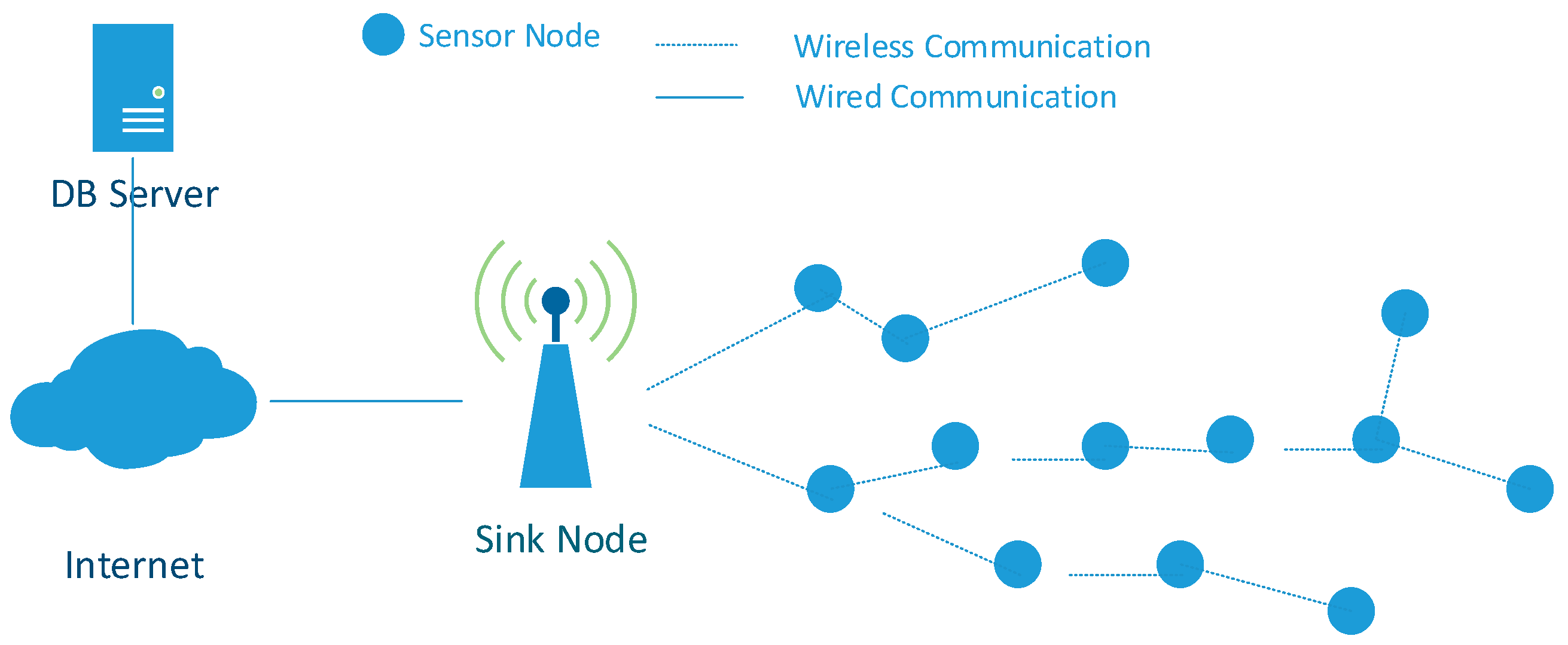
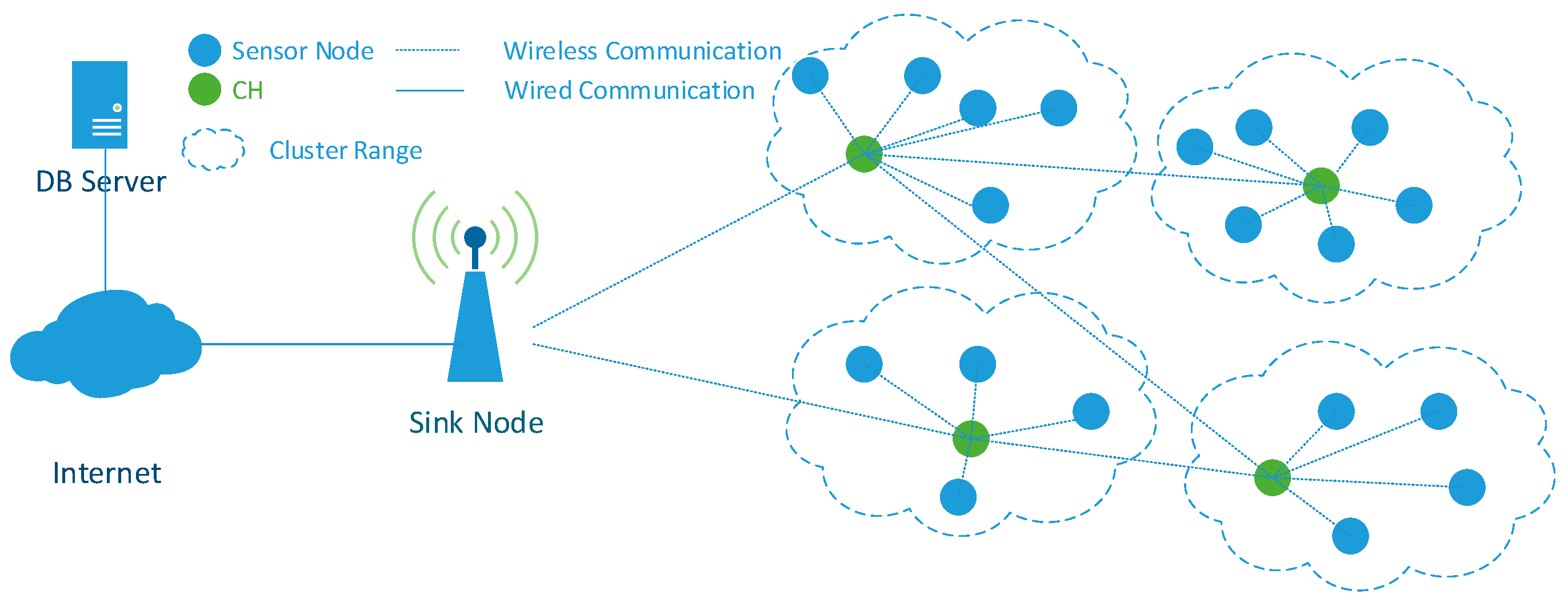
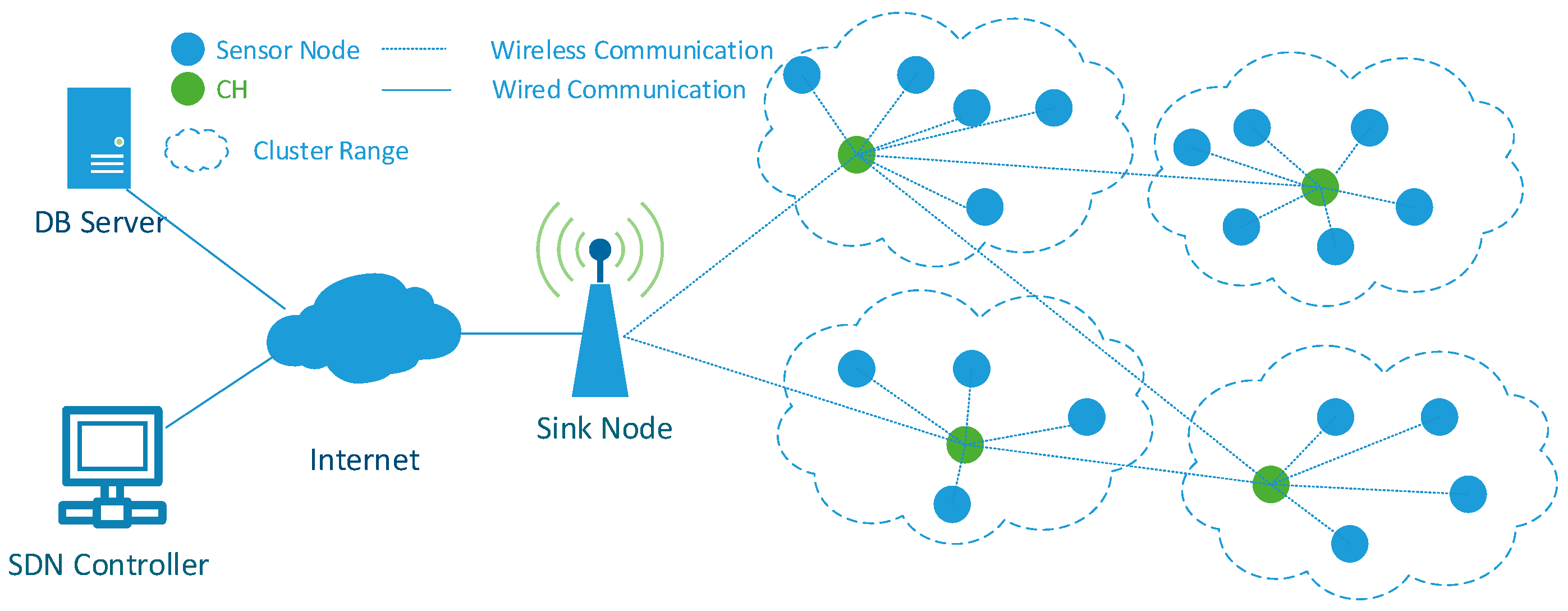
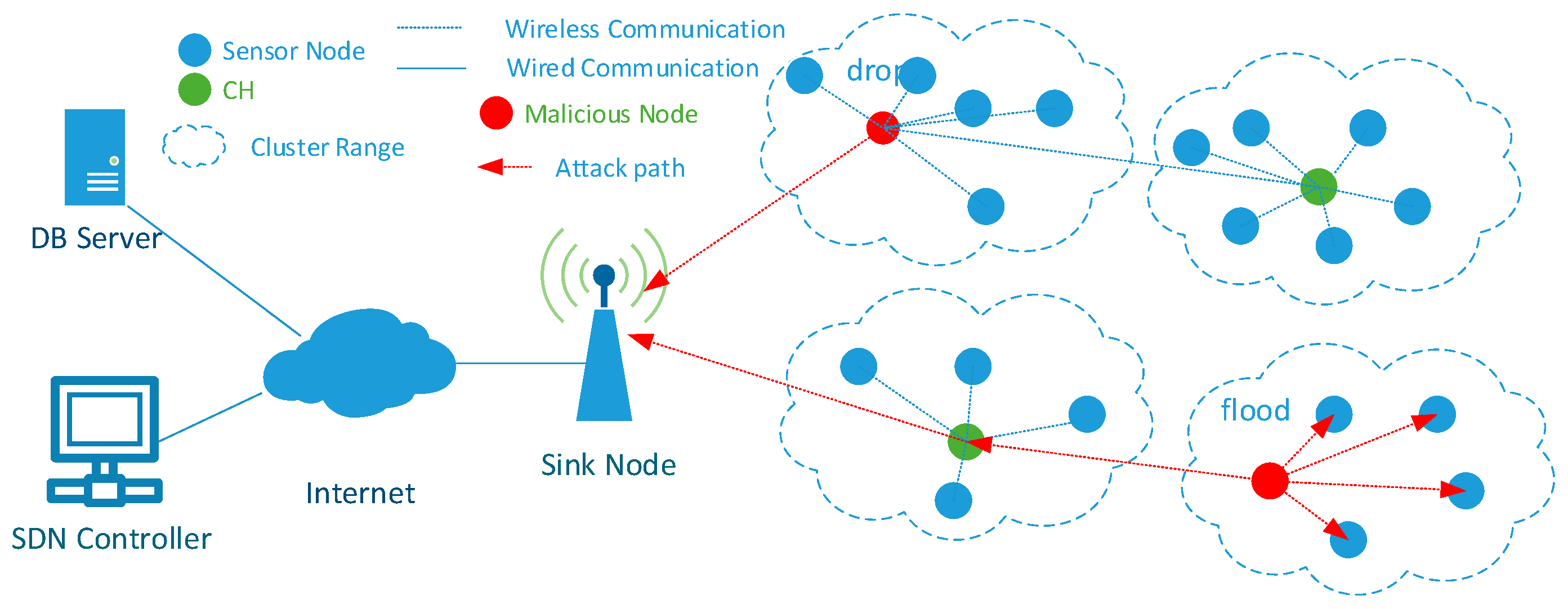
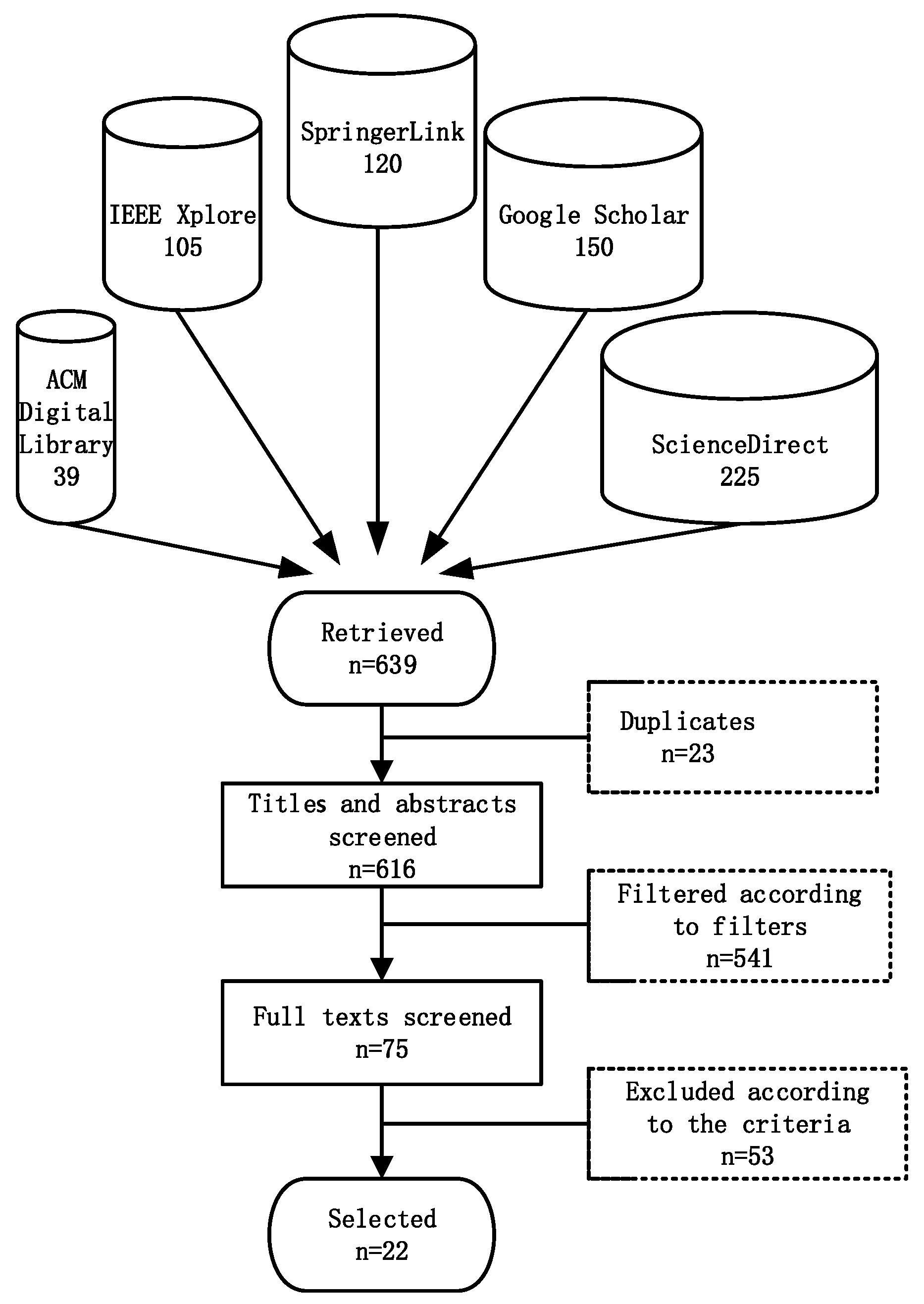
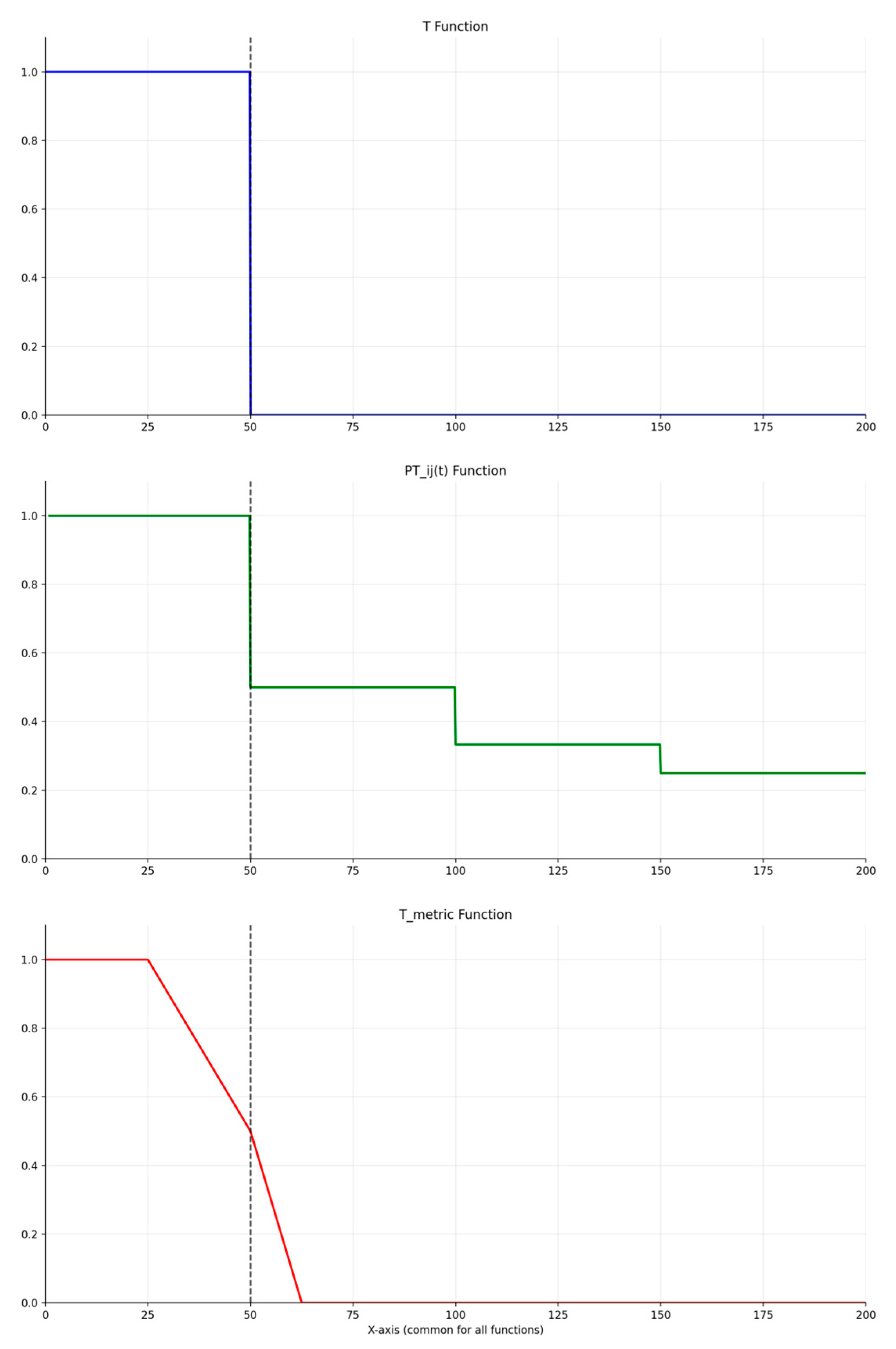
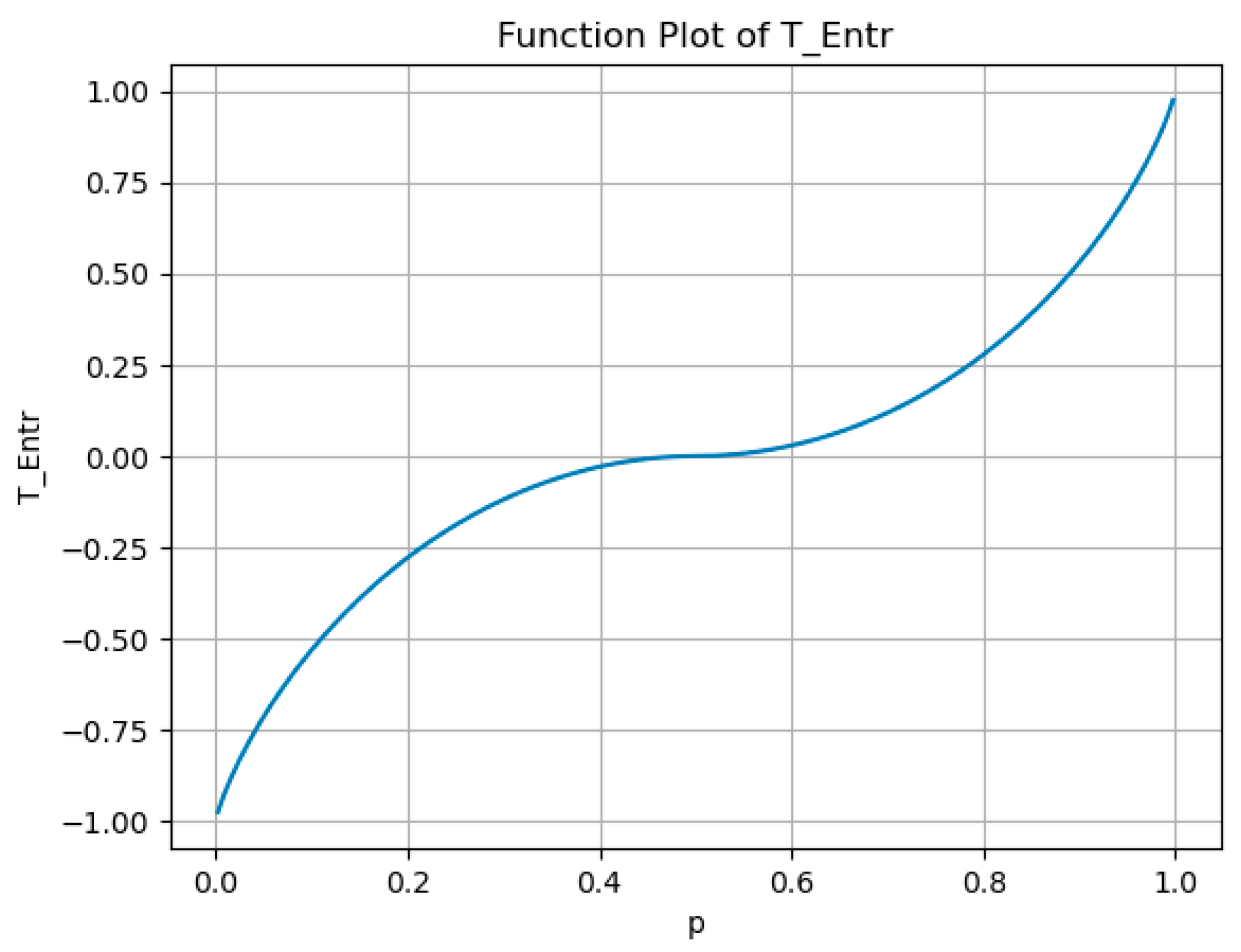
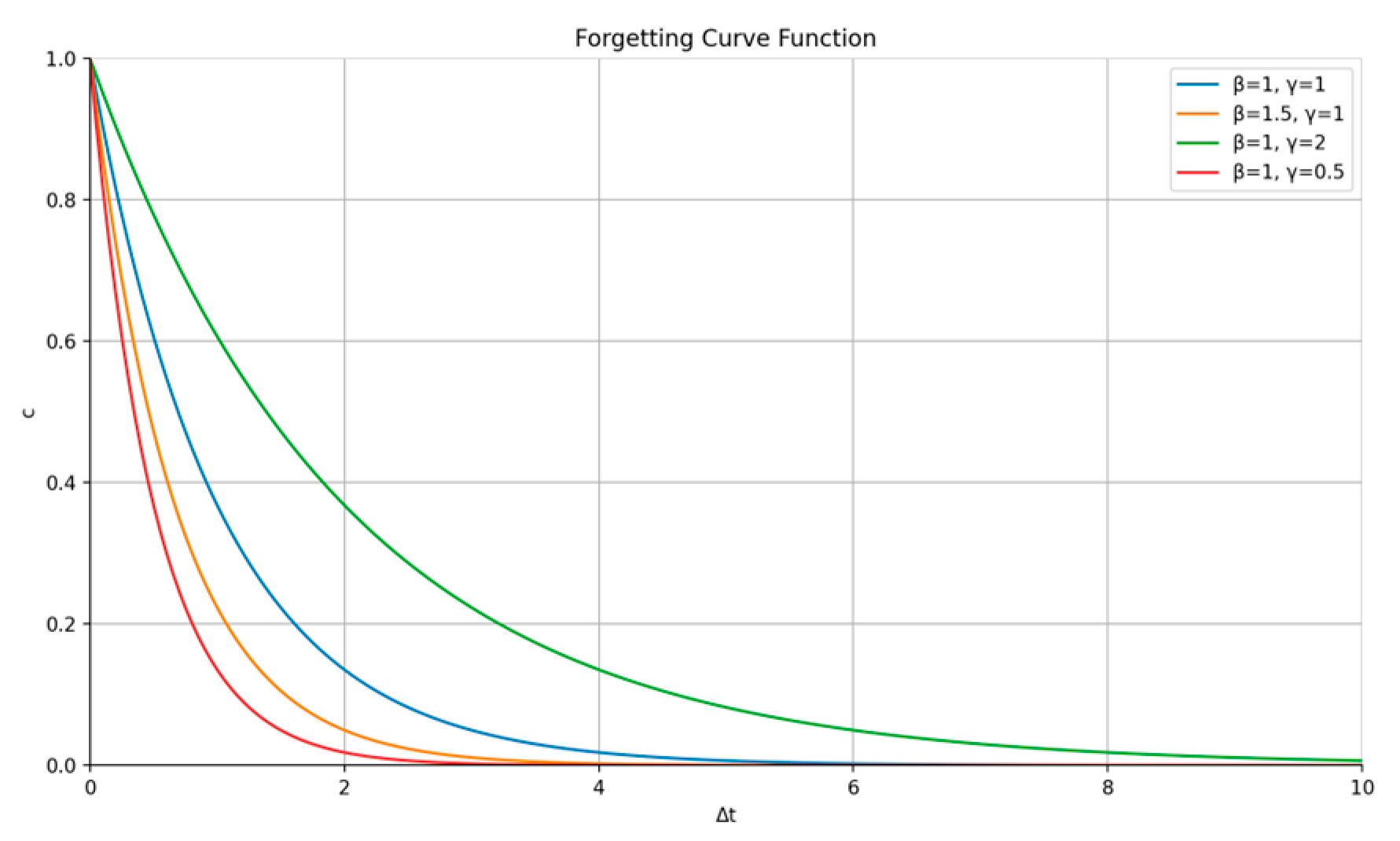
| Criteria | Description |
|---|---|
| Inclusion criteria | Studies focusing on trust models addressing DoS attacks in WSNs. |
| Studies focusing on trust models addressing DoS attacks in SDWSNs. | |
| Peer-reviewed articles, and conference papers. | |
| Studies published in English. | |
| Exclusion criteria | Studies focusing on artificial intelligence or blockchain solutions for WSNs. |
| Review papers. | |
| Non-peer-reviewed sources. | |
| Studies without available full text. |
| Types of DoS Attacks | Impact Mechanisms | Key Impact Features |
|---|---|---|
| 1. Selective Forwarding Attack [4] | MLNs affect the availability of the network services by dropping to a targeted destination node. |
|
| 2. Blackhole Attack [10] | The MLN claims to have the best route, causing all packets to be forwarded to it. It drops all forwarded packets. |
|
| 3. Grey Hole Attack [47] | A variant of the blackhole attack. The MLN drops packets intermittently or selectively. The degradation of network performance is less detectable. |
|
| 4. Flooding Attack [18] | The MLN sends a large number of connection requests or packets and forces the attacked nodes to exhaust their resources by processing an excessive number of invalid requests. |
|
| 5. Sinkhole Attack [47] | The MLN falsifies routing information and causes network congestion by attracting a large amount of network traffic. |
|
| 6. Sybil Attack [5] | The attacker disrupts the topology of the network by adding multiple fake nodes, which reduces the efficiency of the routing and data transmission. |
|
| 7. Vampire Attack [16] | The MLN manipulates network routing protocols to direct packets along longer or circular paths; legitimate nodes consume more energy and fail prematurely. |
|
| 8. DDoS Attack [24] | An enhanced version of the DoS attacks above; launched by multiple MLNs at the same time. |
|
| 9. LDoS Attack [43] | The quality of service of the network is eroded slowly by sending intermittent, low-rate malicious traffic. It is harder to detect. |
|
| 10. Hybrid DoS Attack [13] | Combines multiple attacks at the same time, such as sending malicious traffic while selectively dropping some legitimate packets. |
|
| 11. On–Off Attack [35] | The MLN switches randomly from attack to normal operation to prevent detection. |
|
| 12. New-Flow Attack [4] | A flooding attack targeting the control plane of SDWSNs. The large number of new-flow control messages degrades network performance. |
|
| 13. Bad-Mouthing Attack [5] | The MLN spreads false negative information about legitimate nodes, causing their trust value to degrade. |
|
| 14. Good-Mouthing Attack [5] | The MLN spreads false positive information about other MLNs. |
|
| Trust Evidence Category | Trust Evidence |
|---|---|
| Communication trust evidence [10] | Sending rate—data packets |
| Sending rate—control packets | |
| Receiving rate—data packets | |
| Receiving rate—control packets | |
| Forwarding rate—data packets | |
| Forwarding rate—control packets | |
| Energy trust evidence [14] | Energy consumption rate |
| Data trust evidence [14] | Data accuracy |
| Trust Evidence | Extraction Methods | Comparison |
|---|---|---|
| PSR | Direct interaction. | Included in method ‘nodes’ promiscuous receiving mode. |
| Nodes’ promiscuous receiving mode. | ||
| Retrieve from flow table. | The statistical information in the flow table is derived using the method ‘nodes’ promiscuous receiving mode. | |
| PRR | Direct interaction. | Included in method ‘nodes’ promiscuous receiving mode. |
| Nodes’ promiscuous receiving mode. | ||
| PFR | Watchdog plus sender overhearing receiver. | |
| Watchdog plus third-party overhearing sender and receiver. | Redundant (with method ‘watchdog plus sender overhearing receiver’ selected); increases complexity. | |
| Using ACK messages. | Watchdog plus method ‘watchdog plus sender overhearing receiver’. | |
| Using traffic profiles. | Relies on interactions involving request and response messages related to traffic profiles, leading to communication overhead. | |
| ECR | Calculate the energy consumption rate based on the beacon message. | |
| Convert the energy consumption sequence into the power consumption sequence. | Based on sensor nodes monitoring their own energy consumption with high precision, not very realistic. | |
| DA | Extract differences in data sequences of the evaluating node and the evaluated node. | Less accurate than the method ‘extract the accuracy of the data using an outlier detection algorithm based on all neighborhood data references’. |
| Extract the accuracy of the data using an outlier detection algorithm based on all neighborhood data references. |
| Trust Models | Methods | Comparison |
|---|---|---|
| [5,38] | Dempster–Shafer belief theory method | Suitable for trust models that propagate trust metrics; has strong theoretical support |
| [15,16,24,31,35,42] | Arithmetic mean method | Suitable for trust models that propagate trust values and do not consider the trustworthiness of the recommendation information; accuracy is low |
| [14,17,18,32] | Weighted average method | Suitable for trust models that propagate trust values and consider the trustworthiness of the recommendation information based on the recommender’s trust value; accuracy is moderate |
| [10,30,34,45] | Outlier detection | Suitable for trust models that propagate trust values, using outlier detection methods to evaluate the trustworthiness of the recommendation information; accuracy is high |
| [39] | Forgetting curve method | Suitable for trust models that propagate trust values and do not consider the trustworthiness of the recommendation information; accuracy is low |
| [46] | Intrusion detection system | Uses the IDS to detect network anomalies from the network statistical data |
| [33] | Method based on link quality and node reliability | Suitable for trust models that propagate trust values and do not consider the trustworthiness of the recommendation information; accuracy is low |
| [2] | Selective re-evaluation method | Risk assessment values are not involved in the calculation of trust values, which avoids bad-mouthing attacks, but re-evaluation increases latency and burden |
| Models | Methods | Comparison |
|---|---|---|
| [2,3,5,14,17,18,28,29,38,40,41,45] | Weighted average | Do not consider poor past performance |
| [10] | Improved weighted average | Consider poor past performance |
| [30,33,39] | Time lapse factor | Do not consider poor past performance |
| Author, Year | Weight Assignment Methods | Pros and Cons | ||
|---|---|---|---|---|
| Wu et al., 2019 [14]; Ahmed et al., 2024 [17] | Cases | Trust Values | Weights | Pros: prevents attacks manifested in one trust evidence aspect from being masked by good performance in other aspects Cons: only supports three trust evidence metrics; not very accurate |
| 1 | ||||
| 2 | ||||
| 3 | have mixed values greater and lower than 0.5 | The weight of the trust factor that is greater than 0.5 will be assigned 0 and the remaining weights will be assigned equally | ||
| Almutairi et al. [33] | Pros: dynamic weight allocation Cons: requires human intervention; parameter selection is challenging | |||
| Zhang et al. [28] | ; ; ; De-fuzzify the comprehensive trust value using the centroid method. | Pros: dynamic weight allocation; prevents attacks manifested in one trust evidence aspect from being masked by good performance in other aspects Cons: requires human intervention, parameter selection is challenging, high computational complexity | ||
Disclaimer/Publisher’s Note: The statements, opinions and data contained in all publications are solely those of the individual author(s) and contributor(s) and not of MDPI and/or the editor(s). MDPI and/or the editor(s) disclaim responsibility for any injury to people or property resulting from any ideas, methods, instructions or products referred to in the content. |
© 2025 by the authors. Licensee MDPI, Basel, Switzerland. This article is an open access article distributed under the terms and conditions of the Creative Commons Attribution (CC BY) license (https://creativecommons.org/licenses/by/4.0/).
Share and Cite
Wang, L.; Petrova, K.; Yang, M.L. Trust Models in Wireless Sensor Networks for Defending Against Denial-of-Service Attacks: A Literature Review. Appl. Sci. 2025, 15, 3075. https://doi.org/10.3390/app15063075
Wang L, Petrova K, Yang ML. Trust Models in Wireless Sensor Networks for Defending Against Denial-of-Service Attacks: A Literature Review. Applied Sciences. 2025; 15(6):3075. https://doi.org/10.3390/app15063075
Chicago/Turabian StyleWang, Lijuan, Krassie Petrova, and Mee Loong Yang. 2025. "Trust Models in Wireless Sensor Networks for Defending Against Denial-of-Service Attacks: A Literature Review" Applied Sciences 15, no. 6: 3075. https://doi.org/10.3390/app15063075
APA StyleWang, L., Petrova, K., & Yang, M. L. (2025). Trust Models in Wireless Sensor Networks for Defending Against Denial-of-Service Attacks: A Literature Review. Applied Sciences, 15(6), 3075. https://doi.org/10.3390/app15063075






